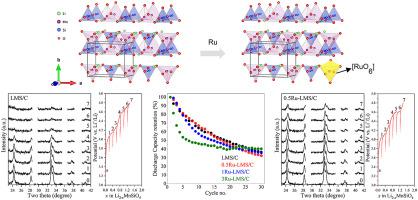当前位置:
X-MOL 学术
›
Solid State Sci.
›
论文详情
Our official English website, www.x-mol.net, welcomes your
feedback! (Note: you will need to create a separate account there.)
Electrochemical Performance of Li2MnSiO4/C Lithium-ion Cathode Materials with Low-Level Doping of Ru in the Mn site
Solid State Sciences ( IF 3.4 ) Pub Date : 2020-12-01 , DOI: 10.1016/j.solidstatesciences.2020.106490 Thanya Phraewphiphat , Adisak Promwicha , Phontip Tammawat , Pimpa Limthongkul , Prae Chirawatkul , Worawarit Kobsiriphat
Solid State Sciences ( IF 3.4 ) Pub Date : 2020-12-01 , DOI: 10.1016/j.solidstatesciences.2020.106490 Thanya Phraewphiphat , Adisak Promwicha , Phontip Tammawat , Pimpa Limthongkul , Prae Chirawatkul , Worawarit Kobsiriphat

|
Abstract Lithium manganese orthosilicate (Li2MnSiO4, LMS), a prospective high-voltage lithium-ion battery cathode material, exhibits poor cycling performance due to structural instabilities during charge and discharge. To alleviate cathode degradation and understand the effects of transition metal dopants on the material properties, Mn was partially substituted by Ru between 0.5 and 3 mol% in carbon-coated LMS (LMS/C) cathode. Undoped LMS/C had orthorhombic LMS structure in the Pmn21 space group. While Ru doping of 0.5 and 1 mol% yielded phase-pure orthorhombic Pmn21 phase, Ru doping of 3 mol% yielded an additional orthorhombic Pmnb phase. The galvanostatic charge-discharge profiles showed a slight improvement in first discharge capacity for 0.5 mol% Ru-doped LMS/C compared to undoped LMS/C, but the discharge capacity decreased with higher doping levels. The capacity retention, however, improved with increasing doping level. In situ XRD results showed that Ru-doped LMS/C was able to retain a higher level of crystallinity than undoped LMS/C during the first charge. By the end of the first charge, in situ XANES of LMS/C revealed that Mn2+ in [MnO4] was partially oxidized to Mn3+ in [MnO6] ligand upon first charging, which coincided with a reduction in crystallinity of LMS/C. As shown by in situ XANES, Ru doping decreased the extent of oxidation of Mn2+ to Mn3+ upon charging. The results revealed that Ru doping of LMS/C between 0.5 and 3 mol% in the Mn site could help maintain Li2MnSiO4 crystallinity during the initial charging step.
中文翻译:

Mn位低掺杂Ru的Li2MnSiO4/C锂离子正极材料的电化学性能
摘要 正硅酸锰锂 (Li2MnSiO4, LMS) 是一种有前景的高压锂离子电池正极材料,由于充放电过程中结构不稳定,循环性能较差。为了减轻阴极降解并了解过渡金属掺杂剂对材料性能的影响,在碳涂层 LMS (LMS/C) 阴极中,Mn 被 0.5 至 3 mol% 的 Ru 部分取代。未掺杂的 LMS/C 在 Pmn21 空间群中具有正交 LMS 结构。虽然 0.5 和 1 mol% 的 Ru 掺杂产生了相纯的正交 Pmn21 相,但 3 mol% 的 Ru 掺杂产生了额外的正交 Pmnb 相。恒电流充放电曲线显示,与未掺杂的 LMS/C 相比,0.5 mol% Ru 掺杂的 LMS/C 的首次放电容量略有提高,但放电容量随着掺杂水平的升高而降低。然而,容量保持率随着掺杂水平的增加而提高。原位 XRD 结果表明,在第一次充电期间,Ru 掺杂的 LMS/C 能够比未掺杂的 LMS/C 保持更高水平的结晶度。在第一次充电结束时,LMS/C 的原位 XANES 显示 [MnO4] 中的 Mn2+ 在第一次充电时被部分氧化为 [MnO6] 配体中的 Mn3+,这与 LMS/C 的结晶度降低一致。如原位 XANES 所示,Ru 掺杂降低了充电时 Mn2+ 氧化为 Mn3+ 的程度。结果表明,在 Mn 位点中掺杂 0.5 至 3 mol% 的 LMS/C 有助于在初始充电步骤中保持 Li2MnSiO4 的结晶度。原位 XRD 结果表明,在第一次充电期间,Ru 掺杂的 LMS/C 能够比未掺杂的 LMS/C 保持更高水平的结晶度。在第一次充电结束时,LMS/C 的原位 XANES 显示 [MnO4] 中的 Mn2+ 在第一次充电时被部分氧化为 [MnO6] 配体中的 Mn3+,这与 LMS/C 的结晶度降低一致。如原位 XANES 所示,Ru 掺杂降低了充电时 Mn2+ 氧化为 Mn3+ 的程度。结果表明,在 Mn 位点中掺杂 0.5 至 3 mol% 的 LMS/C 有助于在初始充电步骤中保持 Li2MnSiO4 的结晶度。原位 XRD 结果表明,在第一次充电期间,Ru 掺杂的 LMS/C 能够比未掺杂的 LMS/C 保持更高水平的结晶度。在第一次充电结束时,LMS/C 的原位 XANES 显示 [MnO4] 中的 Mn2+ 在第一次充电时被部分氧化为 [MnO6] 配体中的 Mn3+,这与 LMS/C 的结晶度降低一致。如原位 XANES 所示,Ru 掺杂降低了充电时 Mn2+ 氧化为 Mn3+ 的程度。结果表明,在 Mn 位点中掺杂 0.5 至 3 mol% 的 LMS/C 有助于在初始充电步骤中保持 Li2MnSiO4 的结晶度。LMS/C 的原位 XANES 显示 [MnO4] 中的 Mn2+ 在第一次充电时被部分氧化为 [MnO6] 配体中的 Mn3+,这与 LMS/C 的结晶度降低一致。如原位 XANES 所示,Ru 掺杂降低了充电时 Mn2+ 氧化为 Mn3+ 的程度。结果表明,在 Mn 位点中掺杂 0.5 至 3 mol% 的 LMS/C 有助于在初始充电步骤中保持 Li2MnSiO4 的结晶度。LMS/C 的原位 XANES 显示 [MnO4] 中的 Mn2+ 在第一次充电时被部分氧化为 [MnO6] 配体中的 Mn3+,这与 LMS/C 的结晶度降低一致。如原位 XANES 所示,Ru 掺杂降低了充电时 Mn2+ 氧化为 Mn3+ 的程度。结果表明,在 Mn 位点中掺杂 0.5 至 3 mol% 的 LMS/C 有助于在初始充电步骤中保持 Li2MnSiO4 的结晶度。
更新日期:2020-12-01
中文翻译:

Mn位低掺杂Ru的Li2MnSiO4/C锂离子正极材料的电化学性能
摘要 正硅酸锰锂 (Li2MnSiO4, LMS) 是一种有前景的高压锂离子电池正极材料,由于充放电过程中结构不稳定,循环性能较差。为了减轻阴极降解并了解过渡金属掺杂剂对材料性能的影响,在碳涂层 LMS (LMS/C) 阴极中,Mn 被 0.5 至 3 mol% 的 Ru 部分取代。未掺杂的 LMS/C 在 Pmn21 空间群中具有正交 LMS 结构。虽然 0.5 和 1 mol% 的 Ru 掺杂产生了相纯的正交 Pmn21 相,但 3 mol% 的 Ru 掺杂产生了额外的正交 Pmnb 相。恒电流充放电曲线显示,与未掺杂的 LMS/C 相比,0.5 mol% Ru 掺杂的 LMS/C 的首次放电容量略有提高,但放电容量随着掺杂水平的升高而降低。然而,容量保持率随着掺杂水平的增加而提高。原位 XRD 结果表明,在第一次充电期间,Ru 掺杂的 LMS/C 能够比未掺杂的 LMS/C 保持更高水平的结晶度。在第一次充电结束时,LMS/C 的原位 XANES 显示 [MnO4] 中的 Mn2+ 在第一次充电时被部分氧化为 [MnO6] 配体中的 Mn3+,这与 LMS/C 的结晶度降低一致。如原位 XANES 所示,Ru 掺杂降低了充电时 Mn2+ 氧化为 Mn3+ 的程度。结果表明,在 Mn 位点中掺杂 0.5 至 3 mol% 的 LMS/C 有助于在初始充电步骤中保持 Li2MnSiO4 的结晶度。原位 XRD 结果表明,在第一次充电期间,Ru 掺杂的 LMS/C 能够比未掺杂的 LMS/C 保持更高水平的结晶度。在第一次充电结束时,LMS/C 的原位 XANES 显示 [MnO4] 中的 Mn2+ 在第一次充电时被部分氧化为 [MnO6] 配体中的 Mn3+,这与 LMS/C 的结晶度降低一致。如原位 XANES 所示,Ru 掺杂降低了充电时 Mn2+ 氧化为 Mn3+ 的程度。结果表明,在 Mn 位点中掺杂 0.5 至 3 mol% 的 LMS/C 有助于在初始充电步骤中保持 Li2MnSiO4 的结晶度。原位 XRD 结果表明,在第一次充电期间,Ru 掺杂的 LMS/C 能够比未掺杂的 LMS/C 保持更高水平的结晶度。在第一次充电结束时,LMS/C 的原位 XANES 显示 [MnO4] 中的 Mn2+ 在第一次充电时被部分氧化为 [MnO6] 配体中的 Mn3+,这与 LMS/C 的结晶度降低一致。如原位 XANES 所示,Ru 掺杂降低了充电时 Mn2+ 氧化为 Mn3+ 的程度。结果表明,在 Mn 位点中掺杂 0.5 至 3 mol% 的 LMS/C 有助于在初始充电步骤中保持 Li2MnSiO4 的结晶度。LMS/C 的原位 XANES 显示 [MnO4] 中的 Mn2+ 在第一次充电时被部分氧化为 [MnO6] 配体中的 Mn3+,这与 LMS/C 的结晶度降低一致。如原位 XANES 所示,Ru 掺杂降低了充电时 Mn2+ 氧化为 Mn3+ 的程度。结果表明,在 Mn 位点中掺杂 0.5 至 3 mol% 的 LMS/C 有助于在初始充电步骤中保持 Li2MnSiO4 的结晶度。LMS/C 的原位 XANES 显示 [MnO4] 中的 Mn2+ 在第一次充电时被部分氧化为 [MnO6] 配体中的 Mn3+,这与 LMS/C 的结晶度降低一致。如原位 XANES 所示,Ru 掺杂降低了充电时 Mn2+ 氧化为 Mn3+ 的程度。结果表明,在 Mn 位点中掺杂 0.5 至 3 mol% 的 LMS/C 有助于在初始充电步骤中保持 Li2MnSiO4 的结晶度。









































 京公网安备 11010802027423号
京公网安备 11010802027423号